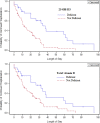25-hydroxyvitamin D is a predictor of COVID-19 severity of hospitalized patients
- PMID: 35503795
- PMCID: PMC9064100
- DOI: 10.1371/journal.pone.0268038
25-hydroxyvitamin D is a predictor of COVID-19 severity of hospitalized patients
Abstract
Objectives: Studies investigating the association between vitamin D and severity of COVID-19 have mixed results perhaps due to immunoassay assessment of total 25-hydroxyvitamin D (tD) (the sum of 25-hydroxyvitamin-D2 [25-OH-D2] and 25-hydroxyvitamin-D3 [25-OH-D3]). Liquid chromatography tandem mass spectrometry (LC-MS/MS) has high analytical specificity and sensitivity for 25-OH-D2 and 25-OH-D3, and thus enables a more accurate assessment of impact on COVID-19 outcomes.
Methods: We established reference intervals for 25-OH-D3 and tD using LC-MS/MS. 25-OH-D2, 25-OH-D3 and tD were quantitated for 88 COVID-19 positive and 122 COVID-19 negative specimens. Chi-square or Fisher's exact tests were used to test associations in binary variables. T-Tests or Wilcoxon rank sum tests were used for continuous variables. Cox proportional hazards were used to test associations between 25-OH-D3 or tD levels and length of stay (LOS). For mortality and ventilation, logistic regression models were used.
Results: COVID-19 patients with deficient (<20 ng/mL) levels of 25-OH-D3 had significantly longer LOS by 15.3 days. COVID-19 P patients with deficient (<20 ng/mL) and insufficient (<30 ng/mL) of tD had significantly longer LOS by 12.1 and 8.2 days, respectively. Patients with insufficient levels of tD had significantly longer LOS by 13.7 days. COVID-19 patients with deficient serum 25-OH-D3 levels had significantly increased risk-adjusted odds of in-hospital mortality (OR [95% CI]: 5.29 [1.53-18.24]); those with insufficient 25-OH-D3 had significantly increased risk for requiring ventilation during hospitalization was found at LCMS insufficient cutoff (OR [95% CI]: 2.75 [1.10-6.90]).
Conclusions: There is an inverse relationship of 25-hydroxyvitamin D levels and hospital LOS for COVID-19 patients. Vitamin D status is a predictor for severity of outcomes. LCMS results are useful for assessing the odds of mortality and the need for ventilation during hospitalization.
Conflict of interest statement
The authors have declared that no competing interests exist.
Figures


References
-
- Entrenas Castillo M, Entrenas Costa LM, Vaquero Barrios JM, Alcalá Díaz JF, López Miranda J, Bouillon R, et al.. Effect of calcifediol treatment and best available therapy versus best available therapy on intensive care unit admission and mortality among patients hospitalized for COVID-19: A pilot randomized clinical study. J Steroid Biochem Mol Biol. 2020;203:105751. doi: 10.1016/j.jsbmb.2020.105751 - DOI - PMC - PubMed
MeSH terms
Substances
LinkOut - more resources
Full Text Sources
Medical

